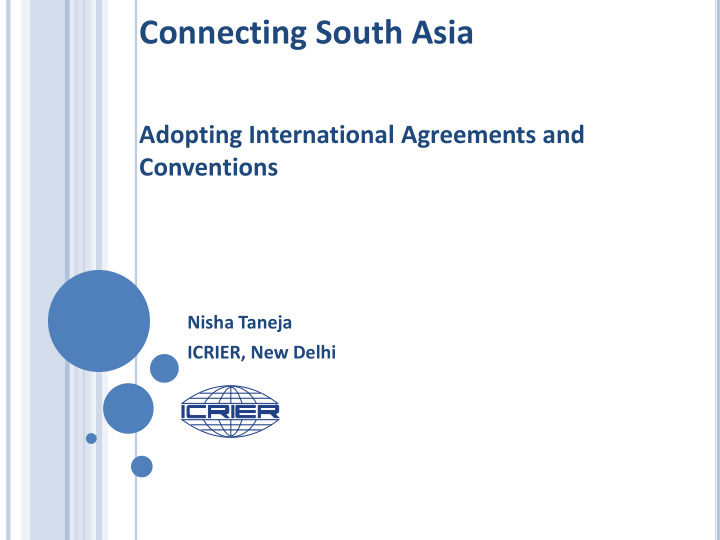



Connecting South Asia Adopting International Agreements and Conventions Nisha Taneja ICRIER, New Delhi
Connectivity Physical infrastructure largely depends on finances But soft infrastructure is more difficult to deal with The soft infrastructure aspects are well documented. There are several studies to show that transaction costs are high both in terms of money and time But what lies at the core is the regulatory framework Lack of regulations Poor design Poor implementation because of weak institutions and poor governance 2
Contd … Institutions are rigid and difficult to change Border institutions have been around for several decades and have been particularly rigid There has been a path dependence so it is even more difficult to change such institutions. For instance why is it difficult to introduce EDI at land borders? Even if it is introduced why is it that it doesn’t work? New institutions can sometimes be more effective as they do not carry any burden An example is the new road route at Wagah which opened in 2005 3
Contd … Institutional changes are needed Institutions are difficult to change It would be better to follow international conventions and agreements 4
Adopting International Agreements and Conventions Trade Facilitation Agreement The TIR Convention 5
A RTCLE 8: B ORDER A GENCY C O - OPERATION Each Member shall, cooperate with other Members with whom it shares a common border with a view to coordinating procedures at border crossings to facilitate cross-border trade. Such cooperation and coordination may include: (a) alignment of working days and hours; (b) alignment of procedures and formalities; (c) development and sharing of common facilities; (d) joint controls; (e) establishment of one stop border post control. 6
ARTICLE 23: INSTITUTIONAL ARRANGEMENTS 2. National Committee on Trade Facilitation Each Member shall establish and/or maintain a national committee on trade facilitation or designate an existing mechanism to facilitate both domestic coordination and implementation of the provisions of this Agreement. 7
Article 2 Opportunity to Comment, Information before Entry into Force, and Consultations 2. Consultations Each Member shall, as appropriate, provide for regular consultations between its border agencies and traders or other stakeholders located within its territory. 8
TIR Convention International Convention put in place by the UNECE in 1975 The convention provides a very effective customs transit to member countries. There are 58 operational member countries. ‘TIR’ stands for Transports Internationaux Routiers (International Road Transport) and is an international harmonized system of Customs control that facilitates trade and transport whilst effectively protecting the revenue of each Country through which goods are carried. 9
10
Advantages of TIR Convention No physical inspection of goods in transit National & international guarantee system A single Customs document Minimum of procedures at borders Reduced delays at borders No restriction in the modes of transport Lower transport costs (reduced export and import costs) 11
Advantage for South Asia Afghanistan is already a member of the Convention Pakistan and Chins are in the process of acceding to the convention. If India becomes a member it will be able to access Central Asian markets India will be able to access Afghanistan through the land border instead of only the sea route 12
Contd … It will help Nepal in accessing international markets through India without being dependent on the Indian treaty which lacks an effective and efficient transshipment modality. If Bangladesh becomes a member then the BCIM connectivity will be more effective for it and it will also get access to Central Asia . 13
How TIR Works A single customs document (called a TIR Carnet) which is accepted at all customs controls (vehicles carry a TIR plate) A guarantee chain which ensures that taxes and duties will be paid at the destination. 14
15
16
Thank You 17
Recommend
More recommend